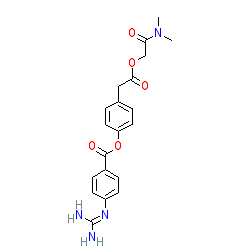GtoPdb is requesting financial support from commercial users. Please see our sustainability page for more information.
|
Synonyms: ONO-3403
camostat is an approved drug
Compound class:
Synthetic organic
Comment: Publications and data are also linked to the camostat mesilate salt (PubChem CID 5284360). There is an active metabolite reported as FOY 251 but this also maps to the mesylate salt (PubChem CID 130394), with the parent compound being PubChem CID 130395
SARS-CoV-2 and COVID-19: Inhibition of TMPRSS2 partially blocks entry of SARS-CoV-2 into Caco-2 cells [1], a result which indicates an opportunity for repurposing this already approved drug for COVID-19. Complete blockade of SARS-CoV-2 entry can be achieved by combined inhibition of TMPRSS2 (by camostat) and the endosomal cysteine proteases cathepsins B and L (by aloxistatin; E-64d). In August 2020 Edinburgh University, the CRUK's Centre for Drug Development and Latus Therapeutics began the Phase 2/3 SPIKE-1 trial (NCT04455815) of camostat in non-hospitalised CoV-2 positive patients, to determine if the drug can reduce the progression of COVID-19 symptoms- access CRUK's trial webpage here. Ligand Activity Visualisation ChartsThese are box plot that provide a unique visualisation, summarising all the activity data for a ligand taken from ChEMBL and GtoPdb across multiple targets and species. Click on a plot to see the median, interquartile range, low and high data points. A value of zero indicates that no data are available. A separate chart is created for each target, and where possible the algorithm tries to merge ChEMBL and GtoPdb targets by matching them on name and UniProt accession, for each available species. However, please note that inconsistency in naming of targets may lead to data for the same target being reported across multiple charts. ✖ |
|
|||||||||||||||||||||||||||||||||||
| No information available. |
Summary of Clinical Use  |
| Spectrum of indications in the literature including pancreatitis. This drug appears to have marketing approval only in Japan and South Korea. More recent clnical indications include cystic fibrosis since prostasin is a channel-activating protease for the regulation of epithelial sodium absorption [3] . SARS-CoV-2 and COVID-19: There a number of clinical trials around the world looking at camostat in COVID-19 patients. These trials are predominantly aimed to assess the ability of camostat to reduce the progression of COVID-19 symptoms in non-hospitalised, ambulatory or outpatients who have tested positive for SARS-CoV-2 infection. |
Mechanism Of Action and Pharmacodynamic Effects  |
| Serine protease inhibitor. |
| Clinical Trials | |||||
| Clinical Trial ID | Title | Type | Source | Comment | References |
| NCT04455815 | A Trial Looking at the Use of Camostat to Reduce Progression of Symptoms of Coronavirus (COVID-19) in People Who Have Tested Positive But Are Able to Stay at Home | Phase 2/Phase 3 Interventional | Cancer Research UK | ||
| NCT04353284 | Camostat Mesylate in COVID-19 Outpatients | Phase 2 Interventional | Yale University | ||
| NCT04608266 | A Multicenter Randomized Trial to Evaluate the Efficacy and Safety of Camostat Mesylate for the Treatment of SARS-CoV-2 Infection - COVID-19 in Ambulatory Adult Patients | Phase 3 Interventional | Assistance Publique - Hôpitaux de Paris | ||







